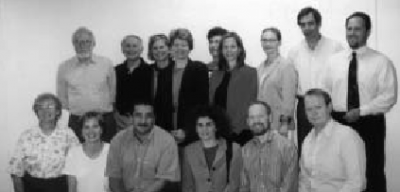A First—A Symposium Held by ICAR Ph.D.s
A First—A Symposium Held by ICAR Ph.D.s
With these landmark events in mind, Chris Mitchell (who served as either the chair or member of a dissertation committee to many Ph.D. students), and I (a member of the first intake of doctoral students), organized another historical event for ICAR—the first gathering of holders of the ICAR Ph.D. The attendees came from as far afield as London and Istanbul for the institute’s first Alumni Symposium held September 13-15.
They were Mohammed Amu-Nimer, Nimet Beriker, Catherine Barnes, Dick Cocozza, Frank Dukes, Jayne Docherty, Larissa Fast, Linda Johnston, Adrienne Kaufman, Mary Jo Larson, Susan Allen Nan, John Stephens, and Josh Weiss. Many more expressed an interest in attending. ICAR’s Ph.D.s are now spread over a number of countries in the world where they are working mostly as academics and consultants.
Below, based on information provided by the individual presenters, is a sample of the work that was presented at the first Alumni Symposium:
• Mohammed Abu-Nimer’s paper discussed the concepts of nonviolence and peace building in Islamic culture and religion. He offered a brief summary of the ideals and values of peace and nonviolence in Islamic religion values, such as adl (justice), sadaqah (charity), ihsan (doing well), etc. The second part of the presentation focused on factors that prevent or challenge the application of such ideals on the ground. Some of these factors are unique to the Islamic cultural context and some others exist in other societies too. Mohammed also focused on the uniqueness of the obstacles that face peace building practitioners in an Islamic context as opposed to non-Muslim communities. The paper is a part of his forthcoming book, Non-violence and Peacebuilding in Islam: Theory and Practice (University Press of Florida).
• Catherine Barnes presented some of the findings from a project comparing mechanisms for public participation in peacemaking. She noted that the common image of negotiations to end internal wars is that the talks typically occur behind closed doors. There are rarely opportunities for those who did not take up arms— including other political groupings, organized civil society, or the wider public—to have an active role in shaping the agreements or endorsing them. According to Catherine, this raises questions about democratization of peacemaking processes and whether there is a viable alternative or complementary model to the elite negotiator pact making that is so common in most international mediation theory and practice.
Her project’s emphasis is on discovering how the interests, aspirations, and values of the different component elements of a society can be directly represented in the negotiations. The project documents the mechanisms from the Guatemala, Mali, Northern Ireland, Philippines, and South Africa peace negotiations that enabled the wider public—in all its diversity—to have a voice in shaping the agreements to guide their post conflict future.
• Dick Cocozza presented on conflict management in the U.S. Congress— how the Congress is a national institution for the management of intractable conflict for more than 270 million citizens with widely diverse interests and values—and the relevance for Alternative Dispute Resolution (ADR) practitioners of congressional approaches to managing conflict. Arguing that the Congress is in many respects a model for dispute resolution in the United States, Cocozza discussed theories that influence congressional conflict management, the congressional system and approaches for conflict management, variables that affect congressional conflict management and the relationship between congressional conflict management and traditional ADR approaches. He highlighted five case study examples of conflict management in the U.S. Congress in the process of making laws—three where conflict management approaches were relatively successful, and two where a general failure to use traditional conflict management approaches resulted in failure.
• Recently, the number of nongovernmental (NGO) personnel that are threatened, harmed, or killed around the world has gained increasing attention. One of ICAR’s newest Ph.D.s, Larissa Fast, presented a paper based on her doctoral research. It examined micro- and macro-level factors contributing to NGO insecurity. More specifically, it explored the influence of NGO attributes (micro-level) on its level of insecurity in similar and different contexts (macro-level) to determine if the profiles of more and less insecure NGOs differ across contexts. By using reported incidents of violence against NGOs and comparing these to indicators of NGO characteristics, Larissa’s research assessed the impact of NGO attributes on their levels of insecurity in Angola and Sierra Leone (similar) and Ecuador (different)—using both qualitative and quantitative techniques. Her findings indicate that on a macro-level, the ambient levels of insecurity were higher in countries experiencing ongoing war compared to those of a relatively stable country.
• Linda Johnston presented a paper covering the updates on the conflict over tobacco in the United States. She explained the complex nature of this conflict and the historical cycles of the conflict over the last 400 years. Linda focused on how social justice would be achieved in the situation and what it might look like. She also reviewed the models for discourse and narrative that she developed during her dissertation research process and examined how the models applied to the current wave of the conflict. She believes the conflict is now focused on social justice issues rather than health-related issues. She finally noted that the resultant narratives from the health-related phase seem to be the foundational narratives for the social justice-related phase.
• Mary Jo Larson discussed the applications of her research to international development practice. Her presentation linked small island contributions to conflict resolution in climate change negotiations with the contributions of women leaders addressing complex health, poverty, safety, and security issues. In her research, Larson relates conflict resolution to the development of a flexible, holistic approach to socio-ecological security. She analyzes symbolic, social, and material dimensions of power relevant to conflict and its resolution. She also uses a conflict resolution systems framework to illustrate flexible, noncoercive contributions to the resolution of complex ecological conflicts.
• Susan Allen Nan presented on coordination between Track One and Track Two diplomacy. Her presentation to the ICAR alumni group, and the valuable feedback offered during discussion, prepared her to present a revised paper at the Secretary’s Open Forum at the State Department on September 23 titled “Conference on Integrating Track One and Track Two Approaches to International Conflict Resolution: What’s Working? What’s Now? How Can We Do Better?” Nan’s paper focused on why Track One and Track Two should coordinate, in which circumstances, and how Track One and Track Two might coordinate.
• John Stephens offered some preliminary thoughts to spur discussion about how to be a reflective conflict resolution practitioner. He noted that how one looks to others for guidance and learning is important. Referring to the writings of Juliana Birkhoff, fellow ICAR Ph.D. alumni, regarding specific projects for mentoring and peer learning in conflict resolution, Stephens offered an example of applying conflict resolution values outside of traditional practice. In his role as a faculty member with research assistants, Stephens worked with Meredith Miller, his 1996-97 research assistant, to explore a more equal decision-making process even as Stephens’ expertise set him “above” Miller. The result was Miller as lead author on “A Partnership Paradigm: A Case Study in Research Assistant and Faculty Interaction,” Journal of Staff, Professional and Organization Development, Vol. 15, No. 3, 111-119. Stephens also noted how he and his coauthors of Reaching for Higher Ground in Conflict Resolution: Tools for Powerful Groups and Communities wrote about their own deficits between the principles they applied in writing the book and how they actually worked together as collaborators.
 • Josh Weiss, another of ICAR’s newest Ph.D.s, presented a paper titled “Peace Process Topographies” in which he took a bird’s-eye view of peace processes in the search for contours, patterns, and models. To do this, Weiss took two perspectives. The first looked at peace processes writ large—meaning all the efforts to negotiate over a long period of time. While this is an important perspective, he placed preliminary importance on the other view of peace processes. That second view was peace processes writ small—analyzing only the negotiation/mediation process that yielded an agreement and the subsequent implementation process. From this he identified five models or patterns. In analyzing these processes and trying to determine models, Josh is seeking to determine when each type of process would best be used in certain types of situations or at different stages of intractable conflicts.
• Josh Weiss, another of ICAR’s newest Ph.D.s, presented a paper titled “Peace Process Topographies” in which he took a bird’s-eye view of peace processes in the search for contours, patterns, and models. To do this, Weiss took two perspectives. The first looked at peace processes writ large—meaning all the efforts to negotiate over a long period of time. While this is an important perspective, he placed preliminary importance on the other view of peace processes. That second view was peace processes writ small—analyzing only the negotiation/mediation process that yielded an agreement and the subsequent implementation process. From this he identified five models or patterns. In analyzing these processes and trying to determine models, Josh is seeking to determine when each type of process would best be used in certain types of situations or at different stages of intractable conflicts.



